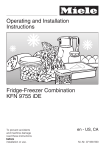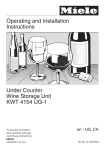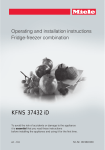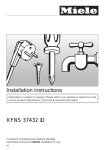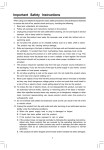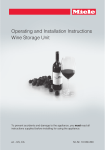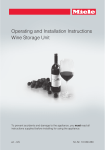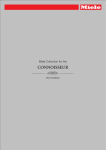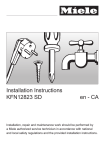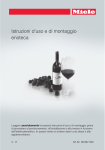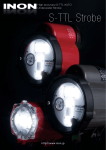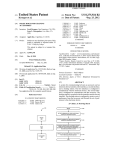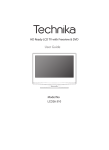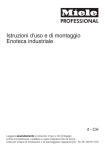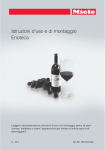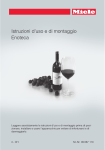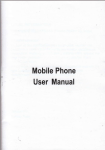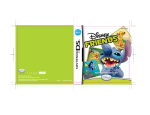Download Miele KWT 6832 SGS
Transcript
Operating and Installation Instructions Wine Storage Unit To prevent accidents and damage to the appliance, you must read all instructions supplied before installing for using the appliance. en - US M.-Nr. 10002240 Contents IMPORTANT SAFETY INSTRUCTIONS. . . . . . . . . . . . . . . . . . . . . . . . . . . . . . . . . 5 Guide to the appliance . . . . . . . . . . . . . . . . . . . . . . . . . . . . . . . . . . . . . . . . . . . . . 9 Accessories . . . . . . . . . . . . . . . . . . . . . . . . . . . . . . . . . . . . . . . . . . . . . . . . . . . . . 12 How to save energy . . . . . . . . . . . . . . . . . . . . . . . . . . . . . . . . . . . . . . . . . . . . . . . 13 Turning the appliance on and off . . . . . . . . . . . . . . . . . . . . . . . . . . . . . . . . . . . . 14 Before first use . . . . . . . . . . . . . . . . . . . . . . . . . . . . . . . . . . . . . . . . . . . . . . . . . . . . 14 Protective film . . . . . . . . . . . . . . . . . . . . . . . . . . . . . . . . . . . . . . . . . . . . . . . . . . 14 Cleaning and Care . . . . . . . . . . . . . . . . . . . . . . . . . . . . . . . . . . . . . . . . . . . . . . 14 Operating the appliance . . . . . . . . . . . . . . . . . . . . . . . . . . . . . . . . . . . . . . . . . . . . 14 Turning the appliance on . . . . . . . . . . . . . . . . . . . . . . . . . . . . . . . . . . . . . . . . . . . . 14 Turning the appliance off . . . . . . . . . . . . . . . . . . . . . . . . . . . . . . . . . . . . . . . . . . . . 15 Turning off the appliance in Sabbath mode . . . . . . . . . . . . . . . . . . . . . . . . . . . 15 Turning off for longer periods of time . . . . . . . . . . . . . . . . . . . . . . . . . . . . . . . . . . 16 Selecting additional settings . . . . . . . . . . . . . . . . . . . . . . . . . . . . . . . . . . . . . . . 17 Safety lock 0 . . . . . . . . . . . . . . . . . . . . . . . . . . . . . . . . . . . . . . . . . . . . . . . . . . . . . 17 Acoustic signals ) . . . . . . . . . . . . . . . . . . . . . . . . . . . . . . . . . . . . . . . . . . . . . . . . 18 Display brightness s. . . . . . . . . . . . . . . . . . . . . . . . . . . . . . . . . . . . . . . . . . . . . . . 19 Sabbath mode ¬ . . . . . . . . . . . . . . . . . . . . . . . . . . . . . . . . . . . . . . . . . . . . . . . . . . 20 Temperature and air quality . . . . . . . . . . . . . . . . . . . . . . . . . . . . . . . . . . . . . . . . 22 Temperature . . . . . . . . . . . . . . . . . . . . . . . . . . . . . . . . . . . . . . . . . . . . . . . . . . . . . 22 Setting the temperature . . . . . . . . . . . . . . . . . . . . . . . . . . . . . . . . . . . . . . . . . . 23 Possible setting values for the temperature . . . . . . . . . . . . . . . . . . . . . . . . . . . 24 Temperature display . . . . . . . . . . . . . . . . . . . . . . . . . . . . . . . . . . . . . . . . . . . . . . . 24 Air quality and humidity . . . . . . . . . . . . . . . . . . . . . . . . . . . . . . . . . . . . . . . . . . . . . 25 DynaCool (constant humidity) m . . . . . . . . . . . . . . . . . . . . . . . . . . . . . . . . . . 25 Air filtering with the active charcoal filter . . . . . . . . . . . . . . . . . . . . . . . . . . . . . 26 Temperature and door alarm . . . . . . . . . . . . . . . . . . . . . . . . . . . . . . . . . . . . . . . 27 Feature lighting . . . . . . . . . . . . . . . . . . . . . . . . . . . . . . . . . . . . . . . . . . . . . . . . . . 29 Turning the feature lighting on and off. . . . . . . . . . . . . . . . . . . . . . . . . . . . . . . . . . 29 Setting the brightness of the feature lighting . . . . . . . . . . . . . . . . . . . . . . . . . . 29 Lighting duration of the feature lighting . . . . . . . . . . . . . . . . . . . . . . . . . . . . . . 30 Storing wine bottles. . . . . . . . . . . . . . . . . . . . . . . . . . . . . . . . . . . . . . . . . . . . . . . 31 Wooden shelves . . . . . . . . . . . . . . . . . . . . . . . . . . . . . . . . . . . . . . . . . . . . . . . . . . 31 Moving the wooden shelves . . . . . . . . . . . . . . . . . . . . . . . . . . . . . . . . . . . . . . . 32 Adjusting the wooden shelves . . . . . . . . . . . . . . . . . . . . . . . . . . . . . . . . . . . . . 32 Labeling wooden shelves . . . . . . . . . . . . . . . . . . . . . . . . . . . . . . . . . . . . . . . . . 33 Contents Bottle presenter . . . . . . . . . . . . . . . . . . . . . . . . . . . . . . . . . . . . . . . . . . . . . . . . . . . 33 Maximum capacity. . . . . . . . . . . . . . . . . . . . . . . . . . . . . . . . . . . . . . . . . . . . . . . . . 34 Sommelier set . . . . . . . . . . . . . . . . . . . . . . . . . . . . . . . . . . . . . . . . . . . . . . . . . . . 35 Setting up the sommelier set . . . . . . . . . . . . . . . . . . . . . . . . . . . . . . . . . . . . . . . . . 35 Covering the runners . . . . . . . . . . . . . . . . . . . . . . . . . . . . . . . . . . . . . . . . . . . . 35 Glass holder . . . . . . . . . . . . . . . . . . . . . . . . . . . . . . . . . . . . . . . . . . . . . . . . . . . 35 Bottle holder . . . . . . . . . . . . . . . . . . . . . . . . . . . . . . . . . . . . . . . . . . . . . . . . . . . 36 Accessory box . . . . . . . . . . . . . . . . . . . . . . . . . . . . . . . . . . . . . . . . . . . . . . . . . 36 Decanting shelves . . . . . . . . . . . . . . . . . . . . . . . . . . . . . . . . . . . . . . . . . . . . . . 37 Decorative shelf . . . . . . . . . . . . . . . . . . . . . . . . . . . . . . . . . . . . . . . . . . . . . . . . 37 Additional bottle presenter . . . . . . . . . . . . . . . . . . . . . . . . . . . . . . . . . . . . . . . . 38 Automatic defrosting . . . . . . . . . . . . . . . . . . . . . . . . . . . . . . . . . . . . . . . . . . . . . . 39 Cleaning and Care . . . . . . . . . . . . . . . . . . . . . . . . . . . . . . . . . . . . . . . . . . . . . . . . 40 Cleaning the outer casing, the door, the interior and accessories . . . . . . . . . . . . 41 Ventilation slits . . . . . . . . . . . . . . . . . . . . . . . . . . . . . . . . . . . . . . . . . . . . . . . . . . . . 42 Door seal . . . . . . . . . . . . . . . . . . . . . . . . . . . . . . . . . . . . . . . . . . . . . . . . . . . . . . . . 42 Compressor and metal grill at the back of the appliance . . . . . . . . . . . . . . . . . . . 42 Active charcoal filter . . . . . . . . . . . . . . . . . . . . . . . . . . . . . . . . . . . . . . . . . . . . . . 43 Changing the active charcoal filter . . . . . . . . . . . . . . . . . . . . . . . . . . . . . . . . . . . . 43 Frequently asked questions . . . . . . . . . . . . . . . . . . . . . . . . . . . . . . . . . . . . . . . . 45 Noises . . . . . . . . . . . . . . . . . . . . . . . . . . . . . . . . . . . . . . . . . . . . . . . . . . . . . . . . . . 50 After sales service . . . . . . . . . . . . . . . . . . . . . . . . . . . . . . . . . . . . . . . . . . . . . . . . 51 Warranty . . . . . . . . . . . . . . . . . . . . . . . . . . . . . . . . . . . . . . . . . . . . . . . . . . . . . . 51 Information for dealers . . . . . . . . . . . . . . . . . . . . . . . . . . . . . . . . . . . . . . . . . . . . 52 Demo mode r. . . . . . . . . . . . . . . . . . . . . . . . . . . . . . . . . . . . . . . . . . . . . . . . . . . . . 52 Caring for the environment . . . . . . . . . . . . . . . . . . . . . . . . . . . . . . . . . . . . . . . . . 56 Electrical connection . . . . . . . . . . . . . . . . . . . . . . . . . . . . . . . . . . . . . . . . . . . . . . 57 Installation . . . . . . . . . . . . . . . . . . . . . . . . . . . . . . . . . . . . . . . . . . . . . . . . . . . . . . 59 Installation location . . . . . . . . . . . . . . . . . . . . . . . . . . . . . . . . . . . . . . . . . . . . . . . . 59 Climate class . . . . . . . . . . . . . . . . . . . . . . . . . . . . . . . . . . . . . . . . . . . . . . . . . . 59 Ventilation . . . . . . . . . . . . . . . . . . . . . . . . . . . . . . . . . . . . . . . . . . . . . . . . . . . . . . . 59 Installation . . . . . . . . . . . . . . . . . . . . . . . . . . . . . . . . . . . . . . . . . . . . . . . . . . . . . . . 59 Niche floor. . . . . . . . . . . . . . . . . . . . . . . . . . . . . . . . . . . . . . . . . . . . . . . . . . . . . 60 Aligning the appliance . . . . . . . . . . . . . . . . . . . . . . . . . . . . . . . . . . . . . . . . . . . . . . 60 Levelling the appliance door . . . . . . . . . . . . . . . . . . . . . . . . . . . . . . . . . . . . . . . . . 60 Door opening angle limiter . . . . . . . . . . . . . . . . . . . . . . . . . . . . . . . . . . . . . . . . . . 60 Contents Appliance dimensions . . . . . . . . . . . . . . . . . . . . . . . . . . . . . . . . . . . . . . . . . . . . . . 61 Dimensions when the door is opened . . . . . . . . . . . . . . . . . . . . . . . . . . . . . . . . . . 61 Adjusting the door hinge . . . . . . . . . . . . . . . . . . . . . . . . . . . . . . . . . . . . . . . . . . 62 Contact details . . . . . . . . . . . . . . . . . . . . . . . . . . . . . . . . . . . . . . . . . . . . . . . . . . 71 IMPORTANT SAFETY INSTRUCTIONS When using the appliance, follow basic safety precautions, including the following: Read all instructions before installation and use to prevent accidents and machine damage. ,This appliance conforms to current safety requirements. Inappropriate use can, however, lead to personal injury and damage to property. To avoid the risk of accidents and damage to the appliance, please read these instructions carefully before using it for the first time. They contain important notes on installation, safety, use and maintenance. Miele cannot be held liable for non-compliance with these instructions. Keep these instructions in a safe place and pass them on to any future owner. ,Danger of injury! At altitudes above 4900 ft (1500 m) there is a risk of the glass door breaking due to changed air pressure conditions! Correct use ~ This appliance is intended for use in domestic households and similar working and residential environments. It is not intended for outdoor use. ~ This appliance is intended for only for storing wine. Any other usage is not supported by the manufacturer and could be dangerous. The manufacturer cannot be held liable for damage resulting from incorrect or improper use or operation. ~ The appliance is not suitable for use in areas where there is a risk of explosion. Miele cannot be held liable for damage resulting from improper or incorrect use of the appliance. ~ Persons who lack physical, sensory or mental abilities, or experience with the appliance should not use it without supervision or instruction by a responsible person. Safety with children ~ Children should be supervised in the vicinity of the appliance. ~ Children ages eight and up may only use the appliance oven without supervision if they have been shown how to use it in a safe manner, and if they are able to recognize and understand the potential risks of improper use. ~ Children must not clean or service the appliance unless they are under supervision. ~ Children should be supervised when they are near the appliance. Do not allow children to play with it or to use the controls. They will not understand the potential dangers posed by it. 5 IMPORTANT SAFETY INSTRUCTIONS ~ Ensure that any packing material is disposed of safely and kept out of the reach of children. Danger of suffocation! Technical safety ~ The refrigerant system is tested for leaks. This appliance complies with statutory safety requirements. ~ This appliance contains the refrigerant Isobutane (R600a), a natural gas which is environmentally friendly. Although it is flammable, it does not damage the ozone layer and does not increase the greenhouse effect. The use of this refrigerant has, however, led to a slight increase in the noise level of the appliance. In addition to the noise of the compressor, you might be able to hear the refrigerant flowing around the system. This is unavoidable, and does not have any adverse effect on the performance of the appliance. Care must be taken during the transportation and setting up of the appliance that no parts of the cooling system are damaged. Leaking refrigerant can cause severe irritation to the eyes. In the event of any damage: – avoid open flames and anything that creates a spark, – disconnect the appliance from the electrical power supply, – air the room in which the appliance is located for several minutes and – contact Miele Service. 6 ~ The more refrigerant there is in an appliance, the larger the room it should be installed in. In the event of a leakage, if the appliance is in a small room, there is the danger of combustible gases building up. For every 8 g of refrigerant at least 1 m3 of room space is required. The amount of refrigerant in the appliance is stated on the data plate inside the appliance. ~ To avoid the risk of damage to the appliance, make sure that the connection data (fuse rating, frequency and voltage) on the data plate corresponds to the household supply. Check that this is the case before connecting the appliance. Consult a qualified electrician if in any doubt. ~ Be certain your appliance is properly installed and grounded by a qualified technician. To guarantee the electrical safety of this appliance, continuity must exist between the appliance and an effective grounding system. It is imperative that this basic safety requirement be met. If there is any doubt, have the electrical system of the house checked by a qualified electrician. ~ If the power cord is damaged, it must be replaced by a Miele authorized technician in order to protect the user from harm. ~ Do not connect the appliance to the electrical supply with a power bar or extension cord. These are a fire hazard and do not guarantee the required safety of the appliance. IMPORTANT SAFETY INSTRUCTIONS ~ Do not use the appliance in areas where there may be moisture or splashing water (e.g. garages, laundry rooms, etc.). Moisture can reach the electrical components and cause a short circuit. ~ This appliance is not to be used in non-stationary locations, such as ships. ~ Do not use a damaged appliance. It could be dangerous. Check the appliance for visible signs of damage. Proper use ~ The appliance is designed for use within a certain climate range (ambient temperatures), and should not be used outside this range. The climate range for your appliance is stated on the data plate inside the appliance. Installing it in a room with too low an ambient temperature, e.g. a garage, will lead to the appliance turning off for longer periods so that it cannot maintain the required temperature. Do not cover or block the air vents. ~ The appliance must be isolated from ~ This can impair the efficiency of the the electricity supply during installation, maintenance and repair work. – the respective fuse has been removed, – the circuit breaker has been tripped, or – the power cord has been unplugged. Pull on the plug and not on the cord when removing it from the outlet. ~ Repairs should only be carried out by a qualified and trained person in strict accordance with local and national safety regulations. Unauthorized repairs could cause personal injury or machine damage and may void the warranty. ~ Repairs and other work performed by unauthorized persons could be dangerous and may void the warranty. ~ Defective components should only be replaced by Miele original parts. Only with these parts can the manufacturer guarantee the safety of the appliance. appliance, increase the electricity consumption and cause damage to the appliance. ~ If you store greasy foods in the appliance or the appliance door, make sure that no oil or grease leaks onto the plastic parts of the appliance. This can cause the plastic to crack and break. ~ Do not store explosive materials in the appliance or any products containing propellants (e.g. spray cans). Electrical components could cause flammable vapors to ignite. Danger of fire and explosion. ~ Do not operate any electrical equipment (e.g. an electric ice cream maker) inside the appliance. Danger of sparking and explosion! ~ If storing alcohol with a high percentage proof, make sure it is tightly closed and stored upright in the appliance. Danger of explosion! 7 IMPORTANT SAFETY INSTRUCTIONS ~ Use only genuine original Miele parts. If parts or accessories from other manufacturers are used, the warranty may become invalid. Cleaning and care Disposal of your old appliance ~ Before disposing of an old appliance, first make the door latches or locks unusable. This way you will prevent children from accidentally locking themselves in and endangering their lives. ~ Do not use any oil or grease on the door seals. They can cause the seals to deteriorate over time. ~ Take care not to damage any part of ~ Never use a steam cleaner to clean – puncturing the refrigerant channels in the evaporator, the appliance. The steam can reach the electrical components and cause a short circuit. ~ Never use a pointed or sharp-edged object to – remove frost or ice, – separate frozen foods or remove ice trays. This will damage the evaporators, causing damage to the appliance. ~ Do not place electric heaters or candles in the appliance to defrost it. These can damage the plastic parts. ~ Do not use defrosting sprays or de-icers, as they could contain substances which could damage the plastic parts or which might cause the build-up of gases and pose a danger to health. 8 the cooling system, for example by – kinking any pipework, – scratching the surface coating. Spraying refrigerant can damage the eyes. SAVE THESE INSTRUCTIONS AND PASS THEM ON TO ANY FUTURE USER Guide to the appliance a On/Off of the entire appliance b Optical interface (for Service use only) c Selection of the upper, middle, or lower wine storage zone d On/Off sensor for the DynaCool function (constant humidity) e On/Off sensor of the feature lighting f X To lower the temperature g Confirmation of a selection (OK button) h Y To raise the temperature i For accessing or leaving settings mode j Deactivation of the temperature and door alarms k Display with temperature and symbols (symbols only visible in settings mode; see table for explanation of symbols) 9 Guide to the appliance Symbols in settings mode: Symbol Meaning Function 0 Safety Lock For preventing inadvertent turning off changing of settings ) Acoustic Signals For turning the button tone on or off and the door alarm if it has been activated r Demo Mode (only visible when Demo mode is active) For turning off Demo mode s Display brightness For adjusting the brightness of the display ¬ Sabbath Mode For turning Sabbath mode on and off Active charcoal filter Lights up when the active charcoal filter needs changing t Confirms that the appliance is connected Electrical supply to the electrical supply; flashes in the (only visible when appliance is turned off or case of a power failure in case of a power failure) ; Alarm (only visible when the temperature or door alarm is sounding) 10 Indicates a door or temperature alarm Guide to the appliance a Lighting strip (in all three wine storage zones) b Selector* bottle presenter c Active charcoal filter (in all three wine storage zones) d Wooden shelves with labels (FlexiFrames with Noteboard) e Operation of the upper, middle, or lower wine storage zone f Isolator pads for the thermal insulation of the storage zones with decanting shelves* on each g Glass holder* h Bottle holder (ConvinoBox) with attached accessories box* i Isolator strips for thermal separation of the zones j Safety glass door with UV filter k Decorative shelf* l Integrated recessed handle * The SommeilerSet consists of: An additional bottle presenter, three wooden shelves (two decanting racks and a decorative shelf), two bars for the decanting racks, a glass holder, a bottle holder, an accssory box and four covers for the runners. 11 Accessories Included accessories Optional accessories Active charcoal filter Active charcoal filter The active charcoal filter in the rear panel of the appliance achieves optimum air quality by filtering the air entering and leaving the appliance. (See "Included accessories" for a description.) Stainless steel maintenance The stainless steel cleaning cloth is soaked with the stainless steel conditioner. It has the same cleaning and protective characteristics as the stainless steel conditioner. Chalk Stainless steel maintenance – Each application of the Miele stainless steel conditioner forms a water and dirt repellent protective coating. It gently removes water marks, fingerprints and other dirt for a uniformly shiny surface. – The stainless steel cleaning cloth (see "Included accessories" for a description.) Use the chalk to annotate the magnetic strips on the wooden shelves to identify your wines quickly and easily. Optional accessories are available from Miele, your Miele dealer or online via the Miele website. 12 How to save energy Installation / Maintenance Normal energy consumption Increased energy consumption In a well-ventilated room. In an enclosed, poorly ventilated room. Protected from direct sunlight. In direct sunlight. Away from heat sources (radiator, range/oven). Near a heat source (radiator, range/oven). Where the room temperature Where the room temperature is ideal, i.e. around 68°F is higher. (20°C). Do not block the ventilation openings, and keep them free of dust. Where the ventilation openings are blocked and full of dust. Compressor and metal grill Dust build-up on the (heat exchanger) at the back compressor and metal grill of the appliance dusted at (heat exchanger). least once a year. Temperature setting 50°F to 54°F / 10°C to 12°C Use Wooden shelves arranged as they were when the appliance was delivered. Only open the door when necessary and for as short a time as possible. Store wine bottles in an organized way. The lower the temperature in the appliance, the higher the energy consumption. Frequent opening of the door for long periods will cause a loss of coldness. The appliance works harder to cool down and the compressor runs for longer periods. Do not overfill the appliance in order to allow the air to circulate. 13 Turning the appliance on and off Before first use Protective film Stainless steel surfaces have a layer of protective foil to prevent scratching during transportation. ^ Do not remove the foil until the appliance has been positioned in its final location. Start at one of the top corners. Turning the appliance on The electrical supply symbol t will appear in the display as soon as the appliance has been turned on at the main power supply. ^ Touch the On/Off button. Cleaning and Care ^ Immediately after removing the protective foil, treat stainless steel surfaces with the Miele stainless steel conditioning agent supplied with the appliance. Important! Each application of the Miele stainless steel conditioner forms a durable protective film that is stain and water resistant! ^ Clean the inside of the appliance and the accessories with lukewarm water and liquid dish soap and then dry with a soft cloth. Operating the appliance The appliance is operated with the use of touch keys activated by a finger. A tone will sound each time a button is touched. You can deactivate this, if you wish (see "Selecting additional settings - Acoustic signals"). 14 The electrical supply symbol t will then go out and the appliance will start to cool. The sensors for the upper, middle, and lower wine storage zones will then appear in the control panel. The selected zone will be highlighted yellow and the temperature of the selected zone will show in the display. The first time the appliance is turned on the sensors for the wine storage zones and the alarm symbol ; will flash until the selected temperature has been reached in the zones. As soon as the set temperature has been reached, the sensor for the respective wine storage zone will light up constantly. the alarm symbol ; will go out as soon as the set temperatures have been reached in each zone. The interior lighting will come on when the door is opened. Turning the appliance on and off A different setting can be set for each storage zone. ^ Tap the sensor button for the wine storage zone for which you want to adjust the settings. The selected sensor button is highlighted in yellow. You can now: – set the temperature – turn on the DynaCool function Please refer to the relevant section in the manual for more information. If you then select the other wine storage zone, the settings for the previously selected zone will remain unchanged. Turning the appliance off ^ Touch the On/Off button. If this does not work, the safety lock 0 is activated. The sensors for the three wine storage zones will then go out. The temperature display will go out and the electrical supply connection symbol t will appear. The interior lighting goes out and the cooling is turned off. Turning off the appliance in Sabbath mode The appliance can be turned off directly at any time. ^ Touch the On/Off button. The temperature display will go out and the electrical supply connection symbol t will appear in the display. The interior lighting goes out and the cooling is turned off. When the appliance is turned back on again, Sabbath mode is deactivated. 15 Turning the appliance on and off Turning off for longer periods of time If the appliance is not going to be used for a longer period of time, ^ turn the appliance off, ^ unplug the appliance or trip the circuit breaker, ^ clean the appliance out and ^ leave the door slightly ajar to air the appliance. If, during a long absence, the appliance is turned off but not cleaned out and the door is left shut, there is a danger of bacteria and odors building up inside the appliance. 16 Selecting additional settings Certain appliance settings can only be selected in the settings mode. The door alarm is automatically disabled when the appliance is in settings mode. Safety lock 0 The safety lock can be activated to prevent: – the appliance being turned off by mistake, – the temperature being changed by mistake, – DynaCool being turned on by mistake, – the feature lighting being turned on by mistake. ^ By touching the X or Y button, you can now select whether the safety lock is activated or deactivated: 0: the safety lock is deactivated 1: the safety lock is activated. ^ Touch the OK button to confirm your selection. The selected setting will be adopted and the 0 symbol will flash. Activating and deactivating the safety lock ^ Touch the settings button. All symbols available for selection will appear in the display and the 0 symbol flashes. ^ Touch the settings button to leave the settings mode. Otherwise the appliance will exit the settings mode automatically after approximately one minute. The 0 symbol will appear in the display when the lock is activated. ^ Touch the OK button to confirm your selection. The last selected setting flashes in the display and the 0 lights up. 17 Selecting additional settings Acoustic signals ) The appliance features acoustic signals such as a keypad tone and acoustic alarm for the door and temperature alarm. You can turn the button tone or the door alarm acoustic alarm on or off, but you cannot deactivate the temperature alarm. There are four settings to choose from. Option 3 is set the factory, i.e. the button tone and the door alarm are turned on. ^ By touching the X or Y button you can now select: 0: Button tone off; Door alarm off 1: Button tone off; Door alarm on (after 4 minutes) 2: Button tone off; Door alarm on (after 2 minutes) 3: Button tone on; Door alarm on (after 2 minutes) Turning acoustic signals On/Off ^ Touch the OK button to confirm your selection. ^ Touch the settings button. The selected setting will be adopted and the ) symbol will flash. All symbols available for selection will appear in the display and the 0 symbol flashes. ^ Touch the buttons for setting the temperature (X or Y) repeatedly until the ) symbol flashes in the display. ^ Touch the OK button to confirm your selection. The last selected setting flashes in the display and the ) lights up. 18 ^ Touch the settings button to leave the settings mode. Otherwise the appliance will exit the settings mode automatically after approximately one minute. Selecting additional settings Display brightness s You can adjust the brightness of the display to suit the light conditions in the room. The display brightness can be adjusted in steps from 1 to 3. The factory default setting is 3 (maximum brightness). Changing the brightness of the display ^ Touch the settings button. All symbols available for selection will appear in the display and the 0 symbol flashes. ^ Touch the buttons for setting the temperature (X or Y) repeatedly until the s symbol flashes in the display. ^ By touching the X or Y button, you can now alter the brightness of the display: 1: Dimmest setting 2: Medium setting 3: Brightest setting. ^ Touch the OK button to confirm your selection. The selected setting will be adopted and the s symbol will flash. ^ Touch the settings button to leave the settings mode. Otherwise the appliance will exit the settings mode automatically after approximately one minute. ^ Touch the OK button to confirm your selection. The last selected setting flashes in the display and the s lights up. 19 Selecting additional settings Sabbath mode ¬ Turning on Sabbath mode The appliance offers a Sabbath mode for the purposes of religious observance. The following are turned off: – the interior lighting when the door is opened, – all acoustic and optical signals, ^ Touch the settings button. All symbols available for selection will appear in the display and the 0 symbol flashes. – the temperature display, – DynaCool (if previously turned on) The following can be selected: – the settings sensor for turning off Sabbath mode ^ Touch the buttons for setting the temperature (X or Y) repeatedly until the ¬ symbol flashes in the display. – and the On/Off button The Sabbath mode function will turn itself off automatically after approx. 120 hours. Temperature regulation is limited in Sabbath mode. Ensure that the doors are properly closed, as optical and acoustic alarms are turned off. Any power failure during this time is not shown in the display. After a power failure, the appliance restarts in Sabbath mode. ^ Touch the OK button to confirm your selection. The last selected setting flashes in the display and the ¬ lights up. ^ By touching the X or Y button, you can now turn on Sabbath mode. To do this, select setting 1. ^ Touch the OK button to confirm your selection. 20 Selecting additional settings The selected setting is applied, the ¬ symbol lights up. As soon as the ¬ symbol goes out in the display, Sabbath mode is turned on. ^ Turn off Sabbath mode after the Sabbath has passed. Turning off Sabbath mode ^ Touch the settings button to leave Sabbath mode. The temperature will appear in the display and the interior lighting will come on. 21 Temperature and air quality Wine continues to mature depending on the surrounding conditions. The length of time for which wine can be kept in good condition will therefore depend not only on the temperature but also on the air quality. The wine storage unit with its constant ideal temperature, increased air humidity and odor free atmosphere offers the perfect conditions for storing your wine. It also guarantees a vibration-free environment so that the maturing process is not disturbed. Temperature Wine can be stored at a temperature between 42°F and 64°F (6°C and 18°C). If you are storing white and red wines together, select a temperature between 53°F and 57°F (12°C and 14°C). This is suitable for both red and white wines. At too high a temperature (over 71°F (22°C)), wine matures too quickly, which prevents the aromas from developing further. Wine cannot mature fully at too low a temperature (below 41°F (5°C)). Fluctuations in temperature put wine under stress and interrupt the maturing process. It is therefore very important to maintain a constant temperature. 22 Type of wine Recommended drinking temperature Light, fruity red wines: +157°F to 60°F (4°C to +16°C) Full-bodied red wines: +64°F (18°C) Rosé wines: +46°F to +50°F (8°C to 10°C) Delicate, aromatic white wines: +46°F to +53°F (8°C to 12°C) Full-bodied or sweet white wines: +46°F to +57°F (12°C to 14°C) Champagne, sparkling white wines: +42°F to +50°F (6°C to 10°C) Tip: Store the wine 1 or 2° cooler than the recommended drinking temperature as it warms up a little when poured into the glass. Full-bodied reds should be opened for 2-3 hours before drinking to allow it to breathe and develop its aroma. Temperature and air quality Safety device in case of low ambient temperatures The appliance is equipped with a safety thermostat to protect your wine against a sharp drop in temperature. If the external temperature should drop below this level, a heater element turns on automatically to keep the temperature inside as constant as possible. If the ambient temperature continues to fall, the appliance switches itself off automatically. Isolator panels for thermal separation The appliance has a fixed isolator plate which divides the cabinet into two different zones. This enables you to store different types of wine at the same time, e.g. red wine and champagne. The isolation strips on the inside of the glass door prevent an exchange of heat between the individual zones. Setting the temperature The temperature can be set in all three zones independently of each other. ^ Touch the sensor for the zone for which you wish to change the temperature so that it is highlighted in yellow. The current temperature for the selected zone appears in the display. ^ Set the temperature using the two buttons underneath the display. By touching the button: – the temperature will get colder, – the temperature will get warmer. ^ Tap the OK button to confirm your selection. or ^ Wait approximately 5 seconds after the last press of the button. 23 Temperature and air quality The temperature being set will flash in the display. Possible setting values for the temperature The following information shows in the display when the buttons are tapped: In all three zones, it is possible to set temperatures between 41°F and 68°F (5°C and 20°C). – When first touched: The last temperature selected flashes. – Each subsequent touch of the button: The temperature value adjusts in 1° steps. – Leaving a finger on the sensor: changes the temperature continuously. A negative tone will sound (if the sensor tone is activated) when the lowest or highest possible temperature is reached. Approximately 5 seconds after the last time a sensor has been touched, the current temperature inside the appliance is automatically shown. When the temperature is altered, there is a short delay until the temperature selected is set. The temperature display on the control panel always shows the actual temperature. 24 Temperature display In normal operation, the temperature display shows the actual temperature in the zone. If the temperature in one of the zones is not within the range that the appliance is able to display, dashes will light up in the temperature display. Depending on the ambient temperature and the temperature setting, it can take the appliance a few hours to reach the temperature required and for this temperature to then be shown as a constant temperature in the display. Temperature and air quality Air quality and humidity DynaCool (constant humidity) m A conventional refrigerator with its low humidity level is not the best place to store wine. It is very important to store wine in an atmosphere with a high humidity level so that the corks remain moist on the outside. Low humidity causes corks to dry out from the outside, and so do not seal the bottles as tightly. Wine should be stored lying down to keep the corks moist from the inside too. Air entering the bottle will inevitably spoil the wine. DynaCool raises the relative humidity inside the appliance. It also distributes the humidity and the temperature evenly around the interior so that you can store all your wine under the same excellent conditions. This will create a stable climate in the cabinet which imitates that of a wine cellar. Do not introduce additional moisture into the air, e.g. by placing a bowl of water in the appliance, as this will lead to condensation on the interior walls, which can cause corrosion damage. Turning on DynaCool If you would like to use the wine storage unit to store wine long term, we recommend that you keep the DynaCool function turned on. ^ Tap the button for constant humidity until it lights up yellow. Even if DynaCool has not been turned on, the fans in the appliance will come on automatically when the cooling system switches on to ensure your wine is kept in the optimum climate. The fans automatically turn off when the door is open. 25 Temperature and air quality Turning off DynaCool The appliance uses slightly more energy and is a little noisier when the DynaCool function is turned on. You can turn it off occasionally if you wish. ^ Tap the button for constant humidity until it no longer lights up yellow. Air filtering with the active charcoal filter The activated charcoal filter ensures optimal air replacement and thus air quality. Fresh air from the outside enters the appliance via the active charcoal filter. The DynaCool system then distributes the air evenly throughout the cabinet. Filtering the incoming air through the active charcoal filter ensures that all the air entering the appliance is fresh and free from dust and smells. This in turn ensures your wine does not absorb any unwanted odors. Replace the active charcoal filter when the indicator appears in the display (see "Active charcoal filter"). 26 Temperature and door alarm The appliance is equipped with an alarm system so that the temperature in the three temperature zones cannot rise or fall unnoticed, thus possibly damaging the wine. Turning off the audio alarm If the audio alarm bothers you, it can be silenced. Temperature alarm If the temperature in one of the wine storage zones rises or falls by a certain amount, the sensor for that zone will start flashing in the control panel and the alarm symbol ; will start to flash in the display. An alarm will also sound. The audio and visual signals are triggered, for example: – when the appliance is turned on and the temperature in a temperature zone deviates greatly from the set temperature, – when too much warm ambient air enters the cabinet when bottles are being rearranged or taken out; – when a large number of bottles are stored for the first time, – in the event of a power failure. ^ Touch the sensor button to turn off the alarm. The alarm will stop sounding. The relevant wine storage zone and the alarm symbol ; will continue to flash in the display until the reason for the alarm has been resolved. Safety device in case of low ambient temperatures The appliance is equipped with a safety thermostat to protect your wine against a sharp drop in temperature. If the external temperature should drop below this level, a heater element turns on automatically to keep the temperature inside as constant as possible. If the ambient temperature continues to fall, the appliance switches itself off automatically. As soon as the reason for the alarm has been resolved, the alarm will stop and the alarm symbol ; will go out. The sensor for the relevant zone will light up constantly again. 27 Temperature and door alarm Door alarm An alarm will sound if the door has been left open for longer than 2 minutes. The three sensor buttons of the wine storage zones flash on the control panel. The alarm symbol ; lights up in the display. The alarm will stop when you close the door. The three wine storage zone sensors and the alarm symbol ; will go out. Turning the door alarm off early If the audio alarm bothers you, it can be silenced. ^ Tap the sensor button to turn off the door alarm. The alarm will stop. The three wine storage zone sensors will flash and the alarm symbol ; will light up until you close the door. If the audible tone does not sound in the event of a door alarm, then the audible tone has been turned off in settings mode (see "Selecting additional settings - Audible tones"). 28 Feature lighting The interior lighting can be set to remain on when the door is closed so your wines can be on display at all times. Setting the brightness of the feature lighting The brightness of the feature lighting can be adjusted. Each zone has its own light so all three zones are lit up. Thanks to the use of LED lighting, the wine will not be adversely affected by heat or UV light. Turning the feature lighting on and off ^ Tap the On/Off sensor button for the feature lighting so that it is highlighted in yellow. The interior lighting is now turned on in all three zones, even when the door is closed. ^ Tap the On/Off sensor button for the feature lighting so that it is highlighted in yellow. ^ Tap the sensor button for the feature light again (about four seconds long), until i flashes in the display (after two seconds, ^ flashes). ^ Use the X and Y sensors for altering the temperature to set the feature lighting brightness. Hold the sensors pressed in. The brightness will immediately start to adjust gradually up or down. By tapping the button To turn the feature lighting off again: ^ Tap the On/Off sensor button for the feature lighting so that it is highlighted in yellow. – the lighting becomes dimmer The interior lighting is now turned off when the door is closed. – the lighting becomes brighter ^ Tap the OK button to confirm your choice. 29 Feature lighting The selected brightness is saved for all three wine storage zones. The temperature reappears in the display. As soon as the appliance door is closed, the set brightness for the feature lighting takes effect. When the appliance door is opened, the interior lighting returns to its normal level. By tapping the button: – lighting duration is reduced by 30 minutes Lighting duration of the feature lighting The lighting duration for the feature lighting is set to 30 minutes at the factory. The lighting duration can be set to 30, 60, 90 minutes, up to 00 (unlimited). The feature lighting will have the brightness setting you have selected previously. – lighting duration is increased by 30 minutes. ^ Open the appliance door. The selected lighting duration is saved for all three wine storage zones. The temperature reappears in the display. ^ Tap the On/Off sensor button for the feature lighting so that it is highlighted in yellow. ^ Tap the sensor button for the feature light again (about four seconds long), until ^ flashes in the display. ^ Use the X and Y sensors for altering the temperature to set the feature lighting duration. The duration (in minutes) will flash in the display. 30 ^ Tap the OK button to confirm your choice. The lighting duration set starts again whenever the appliance door is opened and closed. Do not remove the lighting covers. Should the covers be damaged or need to be removed due to damage, use caution. There are lasers in the lighting (laser beam class 1M) which you should avoid looking at directly. Do not use optical instruments (magnifying glass or similar) to look at the lighting. Storing wine bottles Vibration and movement have a negative effect on the maturing process which can affect the taste of the wine. Wooden shelves To avoid disturbing other bottles when removing a bottle of wine, store bottles of the same type beside each other on the same shelf. Avoid stacking bottles on top of one another on the wooden shelves. Always place the bottles in a horizontal position so that the corks can be kept moist on the inside and air is prevented from getting into the bottles. The wooden shelves supported by runners can be extended so that you can insert and remove the wine bottles comfortably. The middle and lower wine storage zone is also located on two wooden shelves on full extenders (the second and third wooden shelf from the top) that make loading and removal particularly comfortable. The other wooden shelves have a partial extender. Please note that only short wooden shelves fit on the top runner of the three storage zones. 31 Storing wine bottles Moving the wooden shelves Adjusting the wooden shelves The wooden shelves can be removed and replaced again if required. The slats in the wooden shelves can be individually adjusted to suit, so that every bottle is stored in perfect safety regardless of shape or size. ^ Pull the wooden shelf forward to the limit stop and lift it up and off the runners. To do so, grab it on the frame. If you need more space for your bottles (for example, to set up the bottle presenter), ^ Simply lift individual slats to move or remove them from the wooden shelves. ^ cover the top runners on both sides which are now not needed with the covers supplied. The thicker side of the cover should point forwards. The covers are held in position with magnets. ^ To replace the racks, set them on the extended runners until they latch. In the process, the magnetic strip should face forward. 32 The slats in the decanter rack and in the SommelierSet rack cannot be adjusted. Storing wine bottles Labeling wooden shelves Bottle presenter For quick and easy identification of the wines in storage, you can use the chalk supplied to annotate the magnetic strips on the wooden shelves. You can write directly on the strips or remove them from the wooden shelf to do so: With the display rack, you can give prominence to selected bottles so that they can be seen even with the door closed. ^ Hold the magnetic strip by the sides and pull it forwards. The magnetic strip is held on the wooden shelf by magnets. ^ Label the magnetic strip with the chalk supplied and replace it on the front of the wooden shelf. ^ The magnetic strip can be wiped clean with a damp cloth. Only use water to wipe the magnetic strips. Do not use a cleaning agent as this would damage the blackboard paint used on the magnetic strips. In order to set up the bottle presenter, the wooden shelf above must be removed: ^ Remove the wooden shelf and put the side covers on the runners. ^ Place the bottle presenter to the front of the desired wooden shelf and lay the wine bottle on the bottle presenter. ^ If you want, turn on the feature light (see "Feature light") to emphasize the selected wine bottle accordingly. 33 Storing wine bottles Maximum capacity Each wooden shelf has a maximum load-bearing capacity of 77 lbs (35 kg). Do not stack bottles on the wooden shelves. A total of 178 Bordeaux bottles (0.75 l) can be stored in the appliance, with 46 in the upper zone, 46 in the middle zone, and 86 in the lower zone. The number 178 bottles can be achieved only using all wooden shelves. The exception are the decanting shelves since neck on neck is not recommended in this case and the decorative shelves at the bottom of the appliance. 34 Sommelier set Covering the runners The sommelier set can be used to have your wine ready for drinking. You can store wine glasses and accessories in the appliance, decant your wine, and store open bottles in the appliance. ^ Place the four covers supplied a over the runners which are now visible with the thicker side of the cover pointing forwards. Glass holder This can be used for storing and chilling wine glasses. Setting up the sommelier set You can place the glass holder and bottle holder with accessory box in the middle or lower wine storage zone. It is important that you select a wooden shelf with a full extender (the second and third wooden shelves in the middle and lower wine tempering zones can be extended fully). You must remove the wooden shelves lying underneath: ^ Pull the wooden shelf forward to the limit stop and lift it up and off the extension rails. To do so, grab it on the frame. To fit the glasses holder b ^ Remove the necessary number of slats and place the glasses holder b on the wooden shelf. The wine decanter can be placed in the middle of the shelf, and stored there if you wish. 35 Sommelier set Bottle holder Accessory box You can store opened wine bottles in the bottle holder c: You can place accessories like a corkscrew, sommelier knife, or chalk on, in, and under the accessory box e. ^ Remove the necessary number of slats on the wooden shelf and place bottle holder c on it. ^ Position the dividers d in the bottle holder to suit the size of bottles being held. They should be held securely and not rattle against each other. ^ Hang the accessory box e into the bottle holder as well and close it with the lid f if necessary. Tip: It is recommended to remove the oxygen from opened bottles of wine to avoid loss of aroma and taste. ^ You can also hang the accessory box e in the middle of the wooden shelf. To do so, remove the corresponding slats and insert the accessory box, which lies on slats on both sides in the process. In this way, you gain space for additional bottles in the bottle holder. 36 Sommelier set Decanting shelves Before you open a bottle of wine, we recommend that you let it lie on the decanting shelf for a few days. Due to the incline of the decanting shelf, the bottom of the bottle lies deeper than the neck of the bottle which means that turbidity settles on the bottom of the bottle. When the wine is poured carefully, the turbidity remains in the bottle. Both wooden shelves and insertable bars provided with the sommelier set can be used to create a decanting shelf: ^ Place the decanting shelf above an isolator plate (see "Appliance overview") so that it latches in the rear. If you place the decanting shelf below the accessory box, pull the top wooden shelf forwards to the limit stop. ^ Lay the wine bottles with the slant to the bottom of the bottle on the wooden shelf so that the turbidity sinks to the bottom of the bottle. Note: The maximum storage capacity is not reached when the decanting shelves are used. To achieve this capacity, remove the bars below the decanting shelves and insert the wooden shelves again. Now the wooden shelf no longer has a slant and the bottles can be stored neck on neck. Decorative shelf ^ Place the bars with the pins facing downward into the holes of the wooden shelf. Place the decorative shelf at the very bottom of the appliance (see "Guide to the appliance"). You can attach the bar at the front or rear of the wooden shelf. If the bar is attached at the front, the wooden shelf slants slightly backwards. In this case, store the wine bottles with the bottom of the bottle to the rear (see figure). If the bar is attached at the rear, the wooden shelf slants slightly to the front. In this case, store the wine bottles with the bottom of the bottle to the front. 37 Sommelier set Additional bottle presenter For the proper presentation of your wines, you will receive two additional bottle presenters together with the sommelier set (see "Storing wine bottles – Bottle presenter"). 38 Automatic defrosting Condensate and frost can build up on the back wall of the appliance while the compressor is running. These are automatically removed and defrosted by the appliance. The condensate is drained away through a channel and drain hole, then fed into an evaporation system at the back of the appliance. 39 Cleaning and Care WARNING! Danger of electric shock. Unplug refrigerator or disconnect power. Danger of fire. Do not damage the refrigerant circuit. – hard, abrasive sponges and brushes, such as pot scrubbers, – eraser sponges, – sharp metal scrapers. Before cleaning ^ Turn off the appliance. ^ Unplug the appliance or trip the circuit breaker. Make sure that water cannot get into the electronic module or the lighting. Do not use steam cleaning apparatus The steam could reach the electrical components and cause a short circuit. The data plate inside the appliance must not be removed. It contains information which is required in the event of a service call. To better maintain your appliance avoid the following: – cleaning products containing soda, ammonia, acid or chloride – lime removers – abrasive cleaning products, such as scouring powder, scouring liquid, or pumice stones – cleaners containing solvents – stainless steel cleaners – dishwasher detergent – oven sprays – glass cleaner (except on the glass in the appliance door) 40 ^ Take any wine bottles out of the appliance and store them in a cool place. ^ Take out any removable parts, e.g. shelves, for cleaning. ^ Remove the magnetic strips from the wooden shelves before cleaning them (see "Labeling wooden shelves"). Cleaning and Care Cleaning the outer casing, the door, the interior and accessories Clean the appliance at least once a month. Remove any soiling immediately so that it does not dry up. ^ Clean the interior with a solution of lukewarm water and a little dishwashing liquid. ^ The wooden shelves should only be wiped with a well damp cloth. They should not get too wet. ^ Use clean water only to wipe the magnetic strips at the front of the wooden shelves. Do not use a cleaning agent as this would damage the blackboard paint used on the magnetic strips. ^ After cleaning, wipe the interior and accessories with a damp cloth, and dry with a soft cloth. Leave the door open to air the appliance for a short while. ^ To clean stainless steel surfaces on the appliance, use the Original Miele ceramic and stainless steel cooktop cleaner. This product contains substances that are gentle to stainless steel surfaces and, unlike stainless steel cleaners, it does not contain polishing agents. Soiling is gently removed and each time the Original Miele Care product for stainless steel is used, it forms a protective film against dirt and water. ^ Each time you clean the stainless steel surfaces of the appliance you should apply the Original Miele care product for stainless steel. This will give them a water and dirt repellent protective coating and help prevent resoiling. ^ Clean the appliance door with a proprietary glass cleaner. 41 Cleaning and Care Ventilation slits After cleaning ^ The ventilation slits should be cleaned on a regular basis with a brush or vacuum cleaner. A build-up of dust will increase the energy consumption of the appliance. ^ Put all shelves and accessories back into the appliance. Door seal Do not use any grease or oil on the door seal as these will cause the seal to deteriorate and become porous over time. ^ The door seal should be cleaned regularly with clean water and then wiped dry with a soft cloth. Compressor and metal grill at the back of the appliance The compressor and metal grill at the back of the appliance (heat exchanger) should be dusted at least once a year. A build-up of dust will increase the energy consumption of the appliance. When cleaning the compressor and metal grill, be careful not to tear off, kink or otherwise damage any wiring or other parts. 42 ^ Connect the appliance again and turn it on. ^ Place the wine bottles back in the appliance and close the door. Active charcoal filter Fresh air from the room enters the appliance through the active charcoal filter, ensuring a fresh, dust-free, odorless air supply. The active charcoal filter should be changed approx. every 12 months. If the indicator light for the active carbon filter change lights up on the display, the active carbon filters must be changed in all three wine storage zones. To confirm the filters have been changed ^ Touch the settings button. All symbols available for selection will appear in the display and the 0 symbol flashes. Changing the active charcoal filter ^ Tap the buttons for setting the temperature (X or Y) repeatedly until the ¬ symbol flashes in the display. ^ Turn the filter 90° clockwise or anti-clockwise. ^ Pull the filter out. ^ Insert a new filter with the handle in the vertical position. ^ Turn the filter 90° clockwise or counterclockwise until it clicks into place. Active charcoal filters can be obtained from Miele or via the Mieleusa.com website ^ Touch the OK button to confirm your selection. The 1 will flash in the display (means: active charcoal filter is fitted in the appliance), the symbol lights up. ^ Touch the symbols for setting the temperature (X or Y), until the 2 symbol is displayed (means: the counter has been reset). 43 Active charcoal filter ^ Touch the OK button to confirm your selection. The selected setting will be adopted and the symbol will flash. ^ Touch the settings button to leave the settings mode. Otherwise the appliance will exit the settings mode automatically after approximately one minute. The active charcoal filter change indicator light will go out. 44 Frequently asked questions With the aid of the following guide minor problems can be corrected without a service call. If, having followed the suggestions below, you still cannot resolve the problem, please contact Miele Service. To prevent cold from escaping, open the appliance doors as little as possible until the malfunction has been corrected. Installation, maintenance and repairs may only be carried out by a suitably qualified and competent person in strict accordance with current national and local safety regulations. Repairs and other work by unqualified persons could be dangerous. The manufacturer cannot be held liable for unauthorized work. The appliance is not cooling. Problem Possible cause The interior lighting does not come on when the door is opened and the temperature is not showing in the display. The appliance has not been ^ Turn the appliance on. The temperature must turned on. light up in the display. The plug is not properly plugged into the electrical outlet. Solution ^ Insert the plug correctly into the socket. The electrical supply connection symbol t appears in the display when the appliance is turned off. Check whether the fuse has ^ Contact a qualified electrician or Miele tripped. If it has there could Technical Service for be a fault with the assistance. appliance, the household electrical wiring or another electrical appliance. The control panel and interior lighting are working. Demo mode is turned on and the r symbol is illuminated in the display. ^ Turn off demo mode (see "Information for dealers Demo mode"). 45 Frequently asked questions The compressor runs more and more often and for longer periods of time, and the temperature in the appliance drops. Problem Possible cause Solution ^ Correct the temperature The temperature in The temperature setting is setting. the appliance is too too low. low. The appliance door has not ^ Check why the appliance door is not closing been closed properly. properly. The door was opened too frequently. ^ Only open the door when necessary and for as short a time as possible. The ventilation gaps have been covered over or have become dusty. ^ Check that the ventilation gaps are not covered up and dust them regularly. The metal grill (heat exchanger) on the back of the appliance is dusty. ^ Dust the metal grill. The ambient temperature is ^ Decrease the ambient temperature. too warm. 46 Frequently asked questions Indicators in the display Problem Possible cause The alarm symbol The door alarm has been ; is lit up and the triggered. three sensor buttons of the wine storage zones are flashing in the control panel. An audible alarm is also sounding. The alarm symbol ; and the sensor button for one of the wine storage zones is flashing and an audible alarm also sounds. The temperature in the respective wine storage zone has risen higher or fallen lower than the temperature set. This could be due to: – the door being opened too frequently Solution ^ Close the door. The sensors and the alarm symbol ; will go out and the audible alarm stops. ^ Rectify the cause of the alarm. The alarm symbol ; goes out and the sensor for the zone concerned lights up constantly. The audible alarm stops. – a blocked ventilation gap – there has been a lengthy interruption of the power supply. The active charcoal This is the reminder to filter change change the active charcoal indicator light filter. lights up. A dash is lit up up/flashing in the display. Only temperatures within the range of the appliance temperature will be displayed. "F1" to "F3" or "S1" to "S9" appear. There is a fault. ^ Replace the active charcoal filter and then confirm the filter change in settings mode (see "Active charcoal filter"). ^ Contact Miele Service. 47 Frequently asked questions Interior lighting Problem Possible cause Solution The interior lighting is not working. To avoid overheating, the lighting turns itself off automatically after approx. 15 minutes if the door is left open. If this is not the case, then there is a fault. ^ Contact Miele Service. The interior lighting is on even when the door is closed. The feature lighting is turned ^ Turn the feature lighting on. off (see "Feature lighting".) 48 Do not remove the lighting covers. Should the covers be damaged or need to be removed due to damage, use caution. Do not use optical instruments (magnifying glass or similar) to look at the lighting (laser beam class 1M). Frequently asked questions Other problems Problem Possible cause There is no acoustic alarm although the door has been open for a long time. This is not a fault. The alarm tone has been turned off in settings mode (see "Selecting additional settings - Acoustic signals"). The appliance cannot be turned off. The safety lock is activated. The 0 symbol is lit up in the display. The slats on the wooden shelves are warping. Volume change due to moisture absorption or drying out is a typical characteristic of wood. An increase in humidity will cause wooden components to warp, which can lead to cracking. Knots and grain patina are part of the natural character of the wood. Mildew has begun Mildew can begin to form on to form on the wine the labels, depending on the bottle labels. type of label adhesive used. Solution ^ Turn off the safety lock (see "Selecting settings deactivating the safety lock"). ^ Clean the wine bottles and remove any adhesive residue. 49 Noises Normal noises What causes them Brrrrr... This noise may get louder for brief periods when the motor kicks on. Blub, blub.... A gurgling noise can be heard when the refrigerant circulates through the pipes. Click.... Clicking sounds occur whenever the thermostat turns the motor on or off. Sssrrrrr.... In multi-section and frost-free appliances, the movement of air circulating through the appliance can sometimes just barely be heard. In appliances with a water tank, a humming noise can be heard when the water pump is running. Crack... A cracking noise can be heard when the appliance materials expand. Keep in mind that a certain amount of noise is unavoidable (from the compressor and the refrigerant circulating through the system). Noises that you can easily eliminate Possible cause Rattling, clinking The appliance is not level. Solution Realign the appliance using a spirit level, by raising or lowering the screw feet underneath the appliance. The appliance is touching another appliance or piece of furniture. Move it away. Drawers, baskets or shelves are jiggling or are stuck. Check all removable items and refit them correctly. Bottles or containers are touching. Separate them. The transport cord clips are Remove the cord clips. still hanging on the back of the appliance. 50 After sales service In the event of a fault which you cannot correct yourself, please contact – your Miele dealer or – Miele Technical Service. See back cover of the this manual contact details. When contacting Miele Technical Service, please quote the model and serial number of your appliance. This information is given on the data plate inside your appliance. Warranty For additional information, please refer to your warranty booklet. See the end of these operating and installation instructions for this telephone number. MieleCare (USA only) MieleCare, our Extended Service Contract program; gives you the assurance of knowing that your appliance investment is covered by 5 years of worry-free ownership. MieleCare is the only Extended Service Contract in the industry that guarantees repairs by a Miele Authorized Service Provider using genuine Miele parts. Only genuine Miele parts installed by factory-trained professionals can guarantee the safety, reliability and longevity of your Miele appliance. Please note that unless expressly approved in writing by the Miele Service department, Extended Service Contracts offered by other providers for Miele products will not be recognized by Miele. Our goal is to prevent unauthorized (and untrained) service personnel from working on your Miele products, possibly doing further damage to them, you and/or your home. To learn more about MieleCare Extended Service Contracts, please contact your appliance dealer or visit us online at: http://mieleusa.com 51 Information for dealers Demo mode r The appliance can be demonstrated in the showroom or at exhibitions in "Demo mode". In this mode the control panel and interior lighting are active but the compressor remains turned off, so that the appliance does not cool down. Turning on Demo mode ^ Keep your finger on the X button until the r symbol appears in the display. ^ Then, take your finger off the X button. Demo mode is turned on and the r symbol is illuminated in the display. Turning off Demo mode ^ Turn the appliance off by touching the On/Off button. The sensors for the three wine storage zones will then go out. The temperature display will go out and the electrical supply connection symbol t will appear. The r is illuminated in the display. ^ Touch the settings button. All symbols available for selection appear in the display and the 0 flashes. ^ Press and hold the X button. ^ Touch the buttons for setting the temperature (X or Y) repeatedly until the r symbol flashes in the display. ^ At the same time, briefly touch the On/Off button (without letting go of the X button). ^ Touch the OK button to confirm your selection. 1 flashes in the display (Demo mode is active) and the r symbol is illuminated. 52 Information for dealers ^ Touch the X or Y button so that 0 appears in the display (Demo mode is inactive). ^ Touch the OK button to confirm your selection. The selected setting will be adopted and the s symbol will flash. ^ Touch the settings button to leave the settings mode. Otherwise the appliance will exit the settings mode automatically after approximately one minute. Demo mode is turned off and the r symbol disappears. 53 54 Installation Instructions Information is subject to change. Please refer to our website to obtain the most current product specification, technical & warranty information. To prevent accidents and machine damage read these instructions before installation or use. Caring for the environment Disposing of the packaging materials The packaging is designed to protect the appliance from damage during transportation. The packaging materials used are selected from materials which are environmentally friendly for disposal and should be recycled. Ensure that any plastic wrappings, bags, etc. are disposed of safely and kept out of the reach of children. Return the packaging to your dealer. Disposal of your old appliance Old appliances may contain materials that can be recycled. Please contact your local recycling authority about the possibility of recycling these materials. Instead, please contact your municipality's waste collection center to return and recycle electric and electronic appliances. Please take care not to damage the pipework while the appliance is being stored for transport to a waste disposal facility. By protecting the pipework, you help keep the coolants and compressor oil from contaminating the environment. Before discarding an old appliance disconnect it from the electrical supply and cut off the power cord to prevent it from becoming a hazard. 56 Electrical connection ,Failure to follow these instructions can result in death, fire, or electrical shock. Improper connection of the equipment grounding conductor may result in electric shock. If you are in any doubt as to whether the appliance has been properly grounded, have the appliance checked by a qualified electrician or service technician. Installation, repairs and other work by unqualified persons could be dangerous. The manufacturer will not be held responsible for damage or injury arising from unauthorized work. Before installing the appliance, verify that the voltage, load and circuit rating information found on the data plate match the household electrical supply. ,Do not ground to a gas pipe. Check with a qualified elictrician if you are not sure the appliance is properly grounded. Do not have a fuse in the neutral or grounding curcuit. ,Electrocution hazard Electrical grounding required. This appliance is equipped with a three-prong (grounding) polarized plug for your protection against possible shock hazards. Do not remove the round grounding prong from the plug. Do not use a two-prong grounding adapter. Do not use extension cords or ungrounded (two prong) adapters. Connect this appliance to a 110 – 120 VAC, 60 Hz and 15 amp (20 amp for side-by-side) circuit (20 amp for side-by-side) with a circuit breaker or fuse. This appliance should have its own separate grounded circuit. The power cord is equipped with a three-prong (grounding) plug for your protection against potential electrical shock. To maintain this protection: – Do not modify the plug by removing the round grounding prong. – Do not use a two-prong adapter. Where a two-prong wall outlet is encountered, contact a qualified electrician and have it replaced with a three-prong outlet in accordance with the local electrical codes and regulations. – Do not use a power cord that is frayed or damaged. – Do not connect the appliance using an extension cord or extension socket. 57 Electrical connection The appliance must be connected to an electrical outlet that is properly grounded. The electrical installation must comply with the applicable electrical code. The plug must be easily accessible and not concealed behind the appliance so that the appliance can quickly be disconnected from the electricity supply in an emergency. In addition, no other appliances should be plugged into a socket located directly behind this appliance. The power cable must not come into contact with the back of the appliance, as they could be damaged by vibrations from the appliance. This may result in a short circuit. Do not use an extension cord to connect the appliance to the power supply. Extension cords do not guarantee the required safety of the appliance (e.g. they pose a danger of overheating). Do not connect the appliance to stand-alone inverters, such as those used with an autonomous energy source, e.g. solar power systems. Otherwise, when the appliance is switched on, peak loads in the system can cause the safety shutdown mechanism to be triggered. This can damage electronic units. In addition, the appliance must not be used with energy-saving devices, which reduce the amount of energy supplied to the appliance and cause it to overheat. If the power cable needs to be replaced, this work must only be performed by a qualified electrician. 58 Installation Climate class WARNING! Danger of tilting! To avoid a hazard due to instability of the appliance, it must be secured in accordance with the instructions. Installation location This appliance should not be installed where it is exposed to direct sunlight or directly adjacent to a heat-producing appliance such as an oven or a radiator. The room temperature should not go above or below the climate range for which the appliance is designed. The higher the ambient temperature of the room, the more energy the appliance requires to operate. The appliance should be installed in a dry, well-ventilated room. When installing the appliance, please be aware: – The electrical socket must be easily accessible in an emergency, not concealed behind the appliance. – The plug and cord must not touch the rear of the appliance as they could be damaged by vibrations from the appliance. – Do not plug in other devices behind this appliance. The appliance is designed for use within a certain climate range (ambient temperatures) and should not be used outside this range. The climate range of the appliance is stated on the data plate inside the appliance. Climate class Room temperature SN N ST T +50°F to +90°F (+10°C to +32°C) +60°F to +90°F (+16°C to +32°C) +60°F to +100°F (+16°C to +38°C) +100°F to 110°F (+16°C to +43°C) Ventilation The appliance can be place with the back side directly against the wall. Make sure, however, that the ventilation slits are not covered to ensure adequate ventilation. The ventilation slits must also be dusted or cleaned on a regular basis. Installation ^ Remove any cord clips from the back of the appliance. ^ Check that all parts at the back of the appliance are unhindered. Carefully remove any hindrance. ^ Carefully push the appliance into position. 59 Installation Niche floor Levelling the appliance door To ensure that the appliance is installed safely and to guarantee its correct functioning, the floor of the space where the appliance is to be installed must be flat and level. The floor at the installation site must consist of hard, non-pliant material. The appliance is extremely heavy when fully loaded, and for this reason it is imperative that the floor it stands on is able to bear its weight. If necessary, the advice of an architect or structural engineer should be sought. The weight of the appliance when empty is 320 lbs / 145 kg. When fully loaded, the approx. weight of the appliance is approx. 827 lbs / 375 kg. Aligning the appliance ^ Make sure that you unscrew the adjustable foot from the hinge plate until it sits on the floor. Then unscrew the foot by a additional 90°. Door opening angle limiter The door opening angle limiter restricts the opening angle to 90°. This may be necessary if the appliance door hits an adjacent wall when opened, for example. Door opening angle limiters are available from your Miele dealer or through Miele Service. ^ To align the appliance, adjust the front feet using the wrench supplied. 60 Installation Appliance dimensions Dimensions when the door is opened 61 Adjusting the door hinge The appliance is supplied right-hand hinged. If left-hand hinging is required, the hinges must be changed. Removing the door ^ Open the appliance door as far as it will go. You will need the following tools for changing the door hinging: Always change the door hinge with the assistance of another person. The glass door is heavy (approx. 66 lbs / 30 kg) and could break. To protect the glass door and your floor from damage during the change of the door hinging, ^ lay a suitable ground covering on the floor in front of the appliance. ^ Lift the cover a at the bottom of the appliance carefully using a slotted screwdriver. ^ Place the red securing device b (supplied with the appliance) on the soft-close mechanism c so that it engages. The restraining clip stops the hinge from snapping shut. Do not remove the clip until told to do so. Be careful not to damage the door seal. If the door seal is damaged, the appliance door may not close properly and there will not be enough refrigeration. ^ Push the pin e up and out. Now the soft-close mechanism and the appliance are no longer connected. 62 Adjusting the door hinge Turning the soft-close mechanism ^ Push the soft-close mechanism c to the outer side. ^ Press the cover f together in the middle and remove it. ^ Unscrew the screws e on the bottom of the appliance door to the left and right of the soft-close mechanism. ^ Move the panel g in the cover to the other side. Caution! When the securing device b has been removed, do not move the front part of the soft-close mechanism in the direction shown! Danger of injury! ^ Place the red securing device b on the soft-close mechanism again. ^ Remove the red securing device b from the soft-close mechanism. 63 Adjusting the door hinge Caution! When the securing device b has been removed, do not move the front part of the soft-close mechanism in the direction shown! Danger of injury! ^ Remove the screw n. ^ Pull the soft-close mechanism c to the outer side and remove it. ^ Push the spacer i to the side of the appliance and remove it. ^ Remove the red securing device b from the soft-close mechanism. ^ Place the cover f on the soft-close mechanism again. ^ Place the red securing device b on the soft-close mechanism again. ^ Attach the cover f with the screws e. ^ Rotate the spacer i by 180° and insert it on the other side again. Push the spacer in as far as it goes to the side of the appliance. ^ Rotate the soft-close mechanism c by 180°. Insert the soft-close mechanism on the outer side first. ^ Attach the spacer i and the soft-close mechanism c together using the screw h. 64 Adjusting the door hinge Removing the door ^ Remove the covers j at the top of the appliance door using a small slotted screwdriver. ^ Remove the bearing bolt l towards the top. Tip: Leave the screw k in the bearing bolt until the bearing bolt is inserted into the other side. ^ Open the appliance door as far as it will go. ^ Carefully lift the door off and place it to one side. ^ Remove the screw k from the hinge bracket and place it into the upper bearing bolt with 3-4 revolutions. Caution! With the next step, you will remove the appliance door from the appliance. The appliance door is heavy and must be held by another person. 65 Adjusting the door hinge Moving the hinge bracket ^ Remove both covers m at the top of the front of the appliance. ^ Unscrew in the hinge bracket n from the top of the appliance, rotate it by 180°, and screw it in on the other side again. 66 ^ Place the covers m on both side front so that they lock into place. In the process, guide the over so that the cut-out is over the hinge bracket. ^ Loosen the adjustable foot o at the bottom of the appliance with the provided wrench. ^ Pull up the bolt p and unscrew it from the adjustable foot o while holding the adjustable foot firmly. Adjusting the door hinge ^ Unscrew the hinge bracket q from the bottom of the appliance. ^ Remove the cover t from the bottom of the appliance. ^ Then remove the adjustable foot o downwards. ^ Loosen the screw u from the bottom of the appliance and place it on the other side. ^ Attach the cover j on the other side. ^ Place the adjustable foot o in the hinge bracket q from the bottom. ^ Place the mount r for the soft-close mechanism on the hinge bracket on the other side. ^ Also place the round cover s on the other side. ^ Screw on the hinge bracket q with the center screw first and then the other two screws. 67 Adjusting the door hinge ^ Screw the bolt p onto the adjustable foot o from the top while making sure it is inserted into the groove. ^ Push in the bearing bolt l until the groove of the bolt is lined up with the borehole of the hinge bracket. ^ Tighten the adjustable foot o. Refitting the door ^ Place the door on the bottom bolt p and guide it up to the hinge bracket. Caution! The appliance door is heavy and must be held by another person. ^ Unscrew the screw k from the bearing bolt and screw it into the borehole of the hinge bracket. ^ Place the bearing bolt l into the hinge bracket from the top. ^ Place the covers j on the appliance door again. 68 Adjusting the door hinge ^ Pull the joint of the soft-close mechanism c towards the mount r. ^ Make sure that you unscrew the adjustable foot from the hinge plate until it sits on the floor. Then unscrew the foot by a additional 90°. Adjusting the lateral alignment of the appliance door If the appliance door is not aligned with the housing side walls, the appliance door can be adjusted using the upper hinge bracket. ^ Place the bolt d into the soft-close mechanism from the top. ^ Remove the red securing device b. ^ Disengage the cover m on the hinge bracket and push it outwards. ^ Snap on the cover a. ^ Position the appliance at its final location. 69 Adjusting the door hinge ^ Turn the cover downwards. ^ Loosen the three screws on the hinge bracket and push the hinge bracket to the left or right. ^ Retighten the screws. ^ Put the cover back into place. ^ Close the door and check that the side edges of the door are aligned with the side walls of the appliance. 70 71 KWT 6832 SGS en - US M.-Nr. 10002240 / 00








































































